You are in preview mode
Catching comets: How we study the solar system’s most intrepid travellers
Zoë Lewis,
PhD Student, Space Physics, Imperial College London
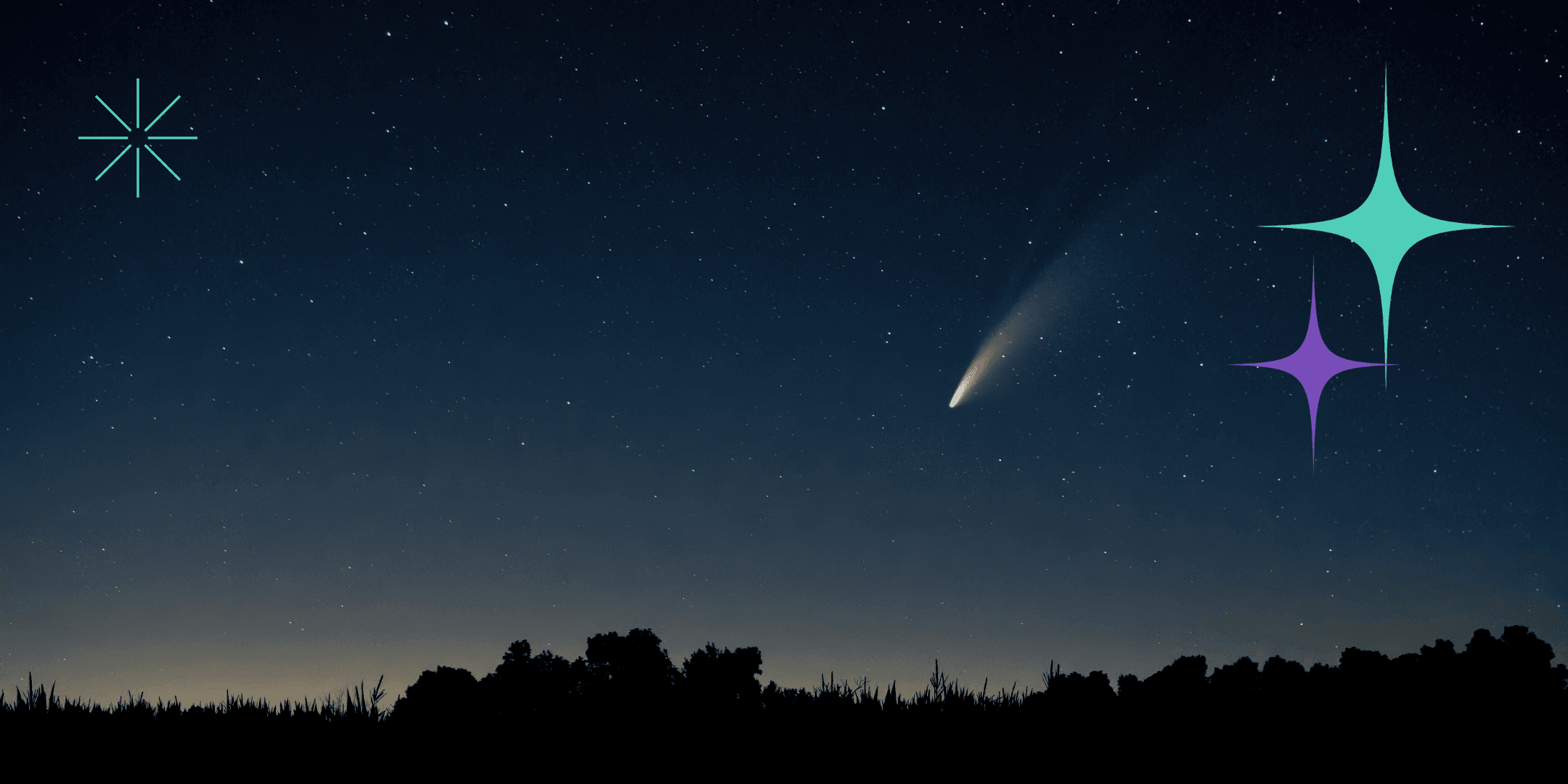
Comets are icy remnants from an ancient solar system, and the space age unlocked new possibilities to study them up close. What have we learnt? |
What is a comet?
Comets are solar system objects that are made of ice and dust. They come from the outer solar system, beyond the orbit of Pluto, where they have been since the solar system was formed 4.5 billion years ago. Things get exciting when the comets get knocked towards the Sun, either by collisions with other objects or by the gravitational influence of planets. They can then begin their journey into the inner solar system, usually on a periodic orbit around the Sun. Planets orbit the Sun in an almost circular path, but comets have much more elliptical orbits and they go from being very far from the Sun (called aphelion) to their closest approach (perihelion). Sometimes, they may only have one perihelion and then leave the inner solar system forever (called a hyperbolic path) or they might get so close to the Sun the first time they visit that they don’t survive to come back out again.
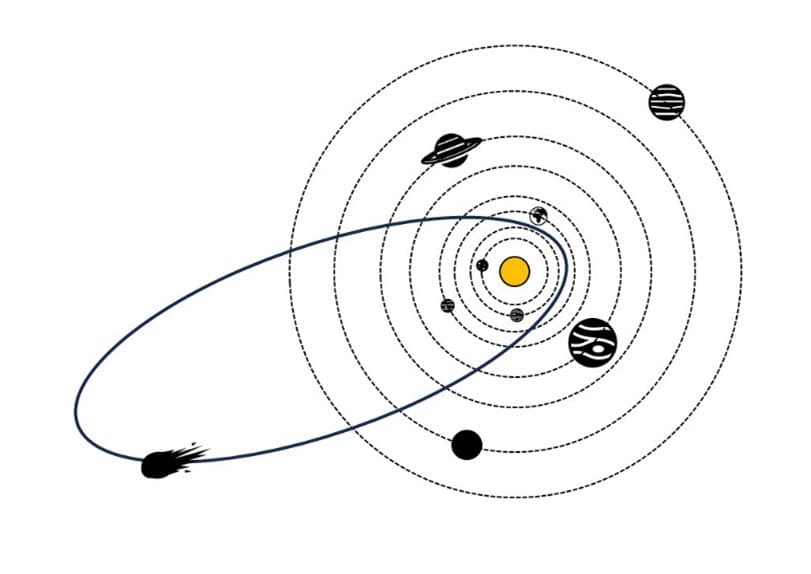
Diagram of a typical periodic comet's path through the solar system. Credit: Zoë Lewis
As the comet gets closer to the Sun, sublimation of the ice on its surface releases lots of gas and dust into space, producing what we call a ‘coma’ and flowing behind it in a tail. The scattering of the sunlight by the dust grains is what gives it the bright glow and tail that the lucky observer may see in the night sky. The most famous comet is comet Halley, which makes its closest approach to the Sun every 75 years and becomes visible from Earth. Its latest appearance was in 1986, so it’s due again in 2061. Mark your calendars!
Comets and the solar wind
Did you know that comets have two tails? The first is the bright one, the dust tail that scatters the sunlight and trails behind the comet on its path through the solar system. The second one is made up of charged particles, ions, which are created through the ionisation of the neutral gas (mostly water!). Unlike the dust tail, the ion tail points directly away from the sun, as if it feels an invisible force pushing it away from the sun. This is a direct effect of something called the solar wind, which is made up of charged particles (called a plasma) that are being constantly ejected from the sun and flowing out into space. The whole solar system is full of these particles, meaning that space is not a true vacuum! The solar wind is very thin, with only around a couple of particles per cubic centimetre near the orbit of the Earth. Despite this, it has real consequences for all objects and planets that sit in the space it fills, called the heliosphere, and the surprising anti-sunward direction of comet ion tails is part of the reason it was discovered.
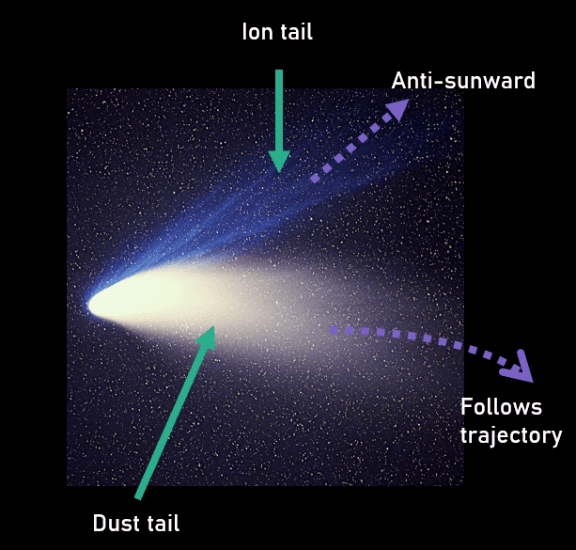
Hale-Bopp 1997, Image credit: E. Kolmhofer, H. Raab; Johannes-Kepler-Observatory, Linz, Austria
For the solar wind flow, which is very fast (supersonic!), a comet is an obstacle, just like a pebble in a fast-flowing river. The flow of ions produced from the ionisation of the neutral atoms in the comet’s gas coma meets the solar wind head-on. This means that when the comet is active enough, then upstream from the nucleus the solar wind gets abruptly slowed down in what is called a ‘bow shock’. A similar effect occurs on Earth and other planets.
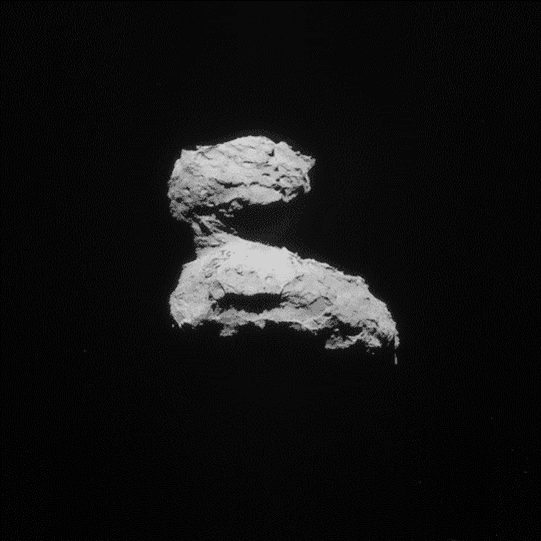
Image description: the nucleus of comet 67P/Churuymov-Gerasimenko, taken by the Rosetta Spacecraft (credit: ESA)
Past comet missions
he first image taken directly of a comet nucleus was from the European Space Agency’s Giotto mission in 1986, which did a flyby of Halley’s comet. A nucleus is darker than coal, so while we can see the coma and tail from Earth, the tiny nucleus is only visible by sending a spacecraft with special camera equipment to capture it. An interesting thing they noticed about comet Halley’s nucleus was that it was an odd shape – a bit like a peanut! This is because comets don’t have enough mass for their gravity to shape the nucleus into a sphere in the same way that planets do. The nucleus of Halley’s comet is around 10km across, which is tiny compared to the millions of kms long tail.
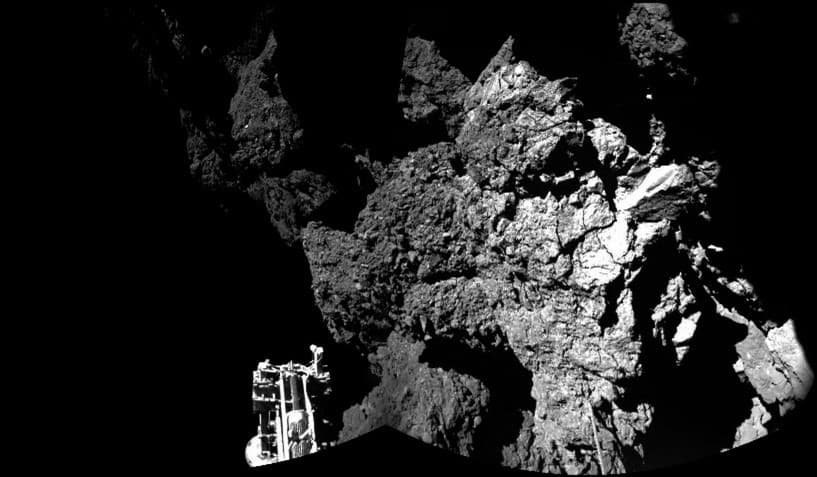
The Giotto mission provided a lot of new information and discoveries, but there’s a limit to how much can be learned from a couple of hours of a flyby. For this reason, a new, longer mission was launched in 2004. This was the Rosetta mission, which spent 2 years escorting a comet, 67P/Churyumov-Gerasimenko, on its journey around the sun. Even more remarkably, the Rosetta spacecraft carried with it a lander module, Philae, which made the first-ever touchdown on the surface of a comet. 67P is smaller and less active than Halley’s comet, with a nucleus a couple of kilometres across and in the shape of a rubber duck. The odd shape is thought to be the result of two different objects colliding together at a slow speed a very long time ago.
A huge number of different chemical compounds were found by the science instruments on board Rosetta. One of the most surprising was glycine discovered in the coma, which is a simple amino acid and the only one that can be formed without the presence of liquid water. Amino acids are some of the most basic building blocks for life on Earth, therefore comets may hold the answers to how these crucial compounds made it here.
In 2016, Rosetta made its way to its final resting place on the comet surface, and the mission was officially over. However, the effort to interpret and understand all the rich data that were taken is ongoing and will likely continue for years to come. 10 years ago, I remember watching news coverage of the landing of the Philae module as a teenager, and now the interpretation of some of the plasma data is a key part of my PhD research!
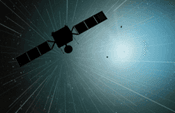
Artist's impression of Comet Interceptor mission. Credit: Geraint Jones, UCL Mullard Space Science Laboratory
The future of comet exploration
So, what’s next? A new mission, Comet Interceptor, was selected by the European Space Agency in 2019 and is due to launch in 2029. The driving idea behind this project is to study a ‘dynamically new’ comet, which is one that is making its way into the inner solar system for the very first time. This means that it won’t have made any trips near the sun yet, and therefore it should be nearly unchanged from when it was formed in the early days of the solar system.
Another novelty of the Comet Interceptor mission is that it will have three spacecraft: A, B1, and B2. The two smaller spacecraft (B1 and B2) will be released from the main one (A) in time for the flyby of the comet so that we can get data from different locations in and build up a better 3D picture of the nucleus, environment, and its interaction with the solar wind.
It’s impossible to predict when a ‘dynamically new’ comet will appear, since they don’t become visible in the night sky until they get close enough to the sun. By that point there won’t be time to launch a spacecraft and send it there. So the plan for Comet Interceptor is rather unconventionally to launch the spacecraft before the target comet is found and to have it waiting in near-Earth space. Meanwhile, scientists on Earth will search for a dynamically new comet using the powerful new Vera Rubin telescope in Chile. Once a good candidate has been identified, the spacecraft will be sent there to do a flyby of the nucleus, taking as much data as quickly as possible and sending it back to Earth to be analysed.
With Comet Interceptor on the horizon and the return of Halley’s comet, there’s plenty to look forward to in the future of cometary science, and there’s still a lot to learn. Watch this space!
Glossary
Nucleus – the solid centre of a comet
Coma – the escaping gas surrounding the nucleus of a comet
Perihelion – The closest approach to the Sun in an object’s orbit
Aphelion – The furthest point from the Sun in an object’s orbit
Sublimation – When a solid substance goes straight to being a gas, skipping the liquid phase.
Ionisation – A process which turns a neutral atom or molecule into a charged one by losing or gaining an electron.
Plasma – Free charged ions and electrons.
Solar wind – Plasma constantly ejected from the sun.
Bow shock – The shock wave formed when the solar wind collides with another plasma in the solar system.
Sources
The Comet Interceptor Mission Jones, Snodgrass et al 2024 Space Science Reviews: https://link.springer.com/article/10.1007/s11214-023-01035-0?fbclid=IwAR2ZkhRjhlzvynecOziGpAb_LKMgqgMgqBuopIgI8IqDwthOvnrw_sBKvKY
ESA Rosetta webpage: https://www.esa.int/Science_Exploration/Space_Science/Rosetta
Article about the discovery of Glycine at comet 67P: https://www.esa.int/Science_Exploration/Space_Science/Rosetta/Rosetta_s_comet_contains_ingredients_for_life
The Giotto mission: https://www.esa.int/Science_Exploration/Space_Science/Giotto_overview
National STEM Learning Centre, University of York, York YO10 5DD. 01904 328300
© STEM Learning Ltd. is a not-for-profit company (05081097)



